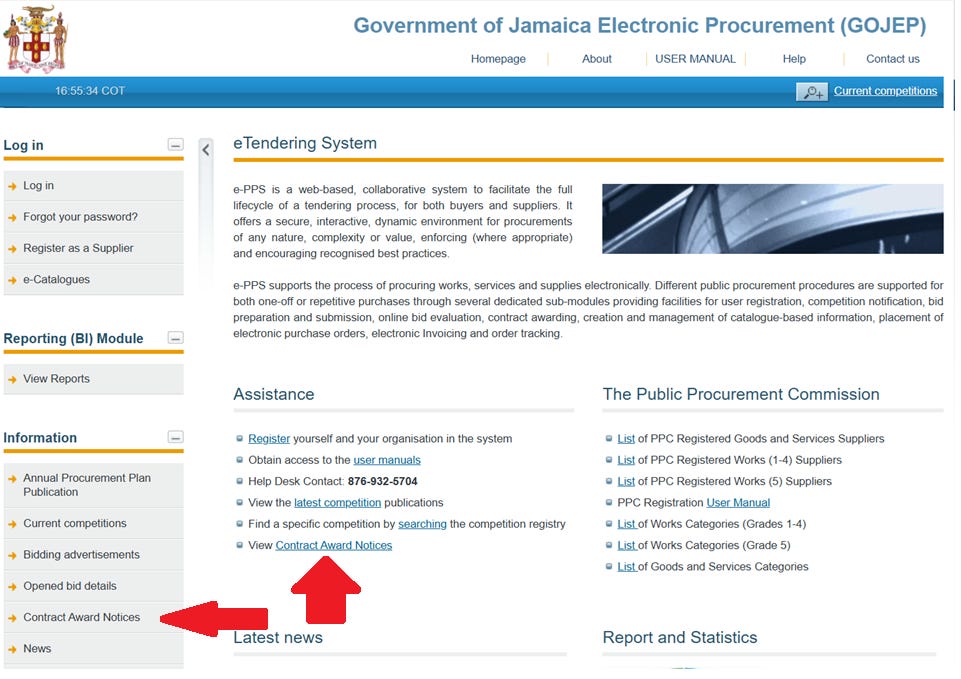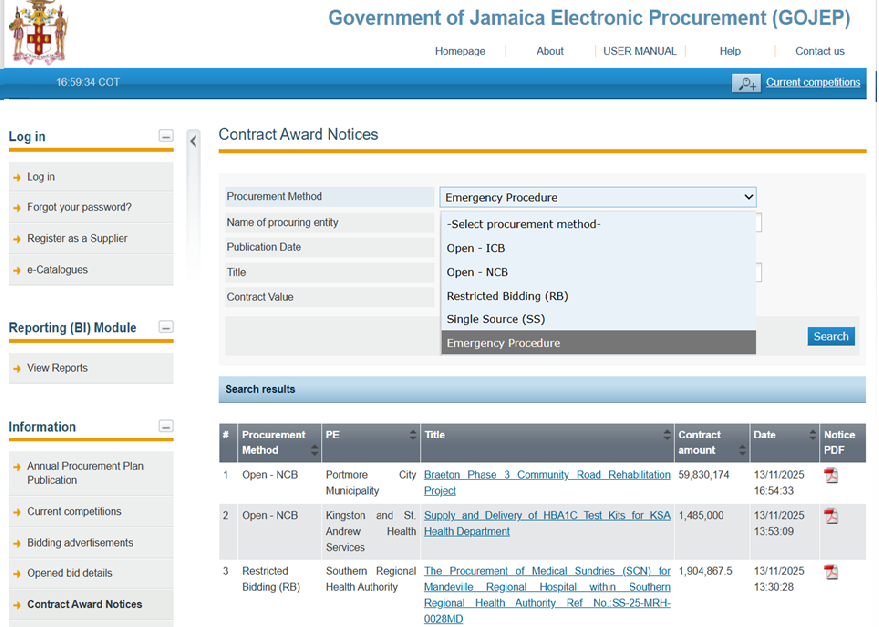A New Boost For Transparency, But More Clarity Still Needed on Jamaica's Hurricane Funding
The Jamaican government has taken a step toward greater transparency in government spending, though gaps in information remain.
This follows a Nov. 11 op-ed published by 18° North that had called for emergency legislation to loosen disclosure restrictions in the Access to Information Act (ATI Act) and the Integrity Commission Act (IC Act) so that information regarding hurricane aid could flow more freely.
While the request was largely dismissed at a press briefing that same day by Information Minister Dana Morris Dixon, who said the focus now is on getting food and shelter to people, not legislative changes, another arm of government may be helping facilitate the release of information in a different way.
On Nov. 13, the Office of Public Procurement Policy (OPPP) within the Ministry of Finance and the Public Service instructed all public entities to upload all notices of emergency contracts to its Government of Jamaica Electronic Procurement (GOJEP) portal within 30 days of a contract award.
This is significant because emergency procurement will likely dominate early Hurricane Melissa spending, so this requirement could provide the first real window into how relief money is being disbursed via contracts. Updates to the only other similar centralized database kept by the Integrity Commission called the Quarterly Contract Awards (QCA) database is no longer being made public because of a clause in the law that has yet to be rectified by parliament.
The Nov. 13 guidance from the OPPP is grounded in law, so disclosure isn’t discretionary.
An amendment earlier this year to the Public Procurement Act, 2015 mandates that a notice of all emergency contracts be given by procuring entities “within one month after the emergency contract was awarded, in the manner specified in guidelines issued by the Office.” It just so happens that those guidelines are now being shared with public entities.
In addition to the mandatory publication via GOJEP, public bodies may also publish notices of emergency contracts on their own websites. So in theory, the public should soon be able to see a description of what’s being procured, contractors, dollar amounts, justifications and timelines for hurricane-related work.
Will There Be Compliance?
But whether this level of disclosure will take place in practice is another story.
That’s because, though GOJEP has been up since 2022 for contracts using other procurement methods like single source, restricted bidding, national and international competitive tendering, the site has been underused.
Despite penalties for noncompliance—including fines or imprisonment — only 8,882 contract notices have been posted since inception, which is an average of 2,220 each year. Contrast that with the un-updated version of the Integrity Commission’s QCA database, and it has 179,461 contracts reported between 2006 and 2020, an average of 11,964 annually. (Updates to the QCA database stopped being shared with the public in 2020 though government entities are still required to submit details of contracts they award for the IC’s internal use.)
Transparency Extends Beyond Procurement
Transparency also extends beyond procurement. It’s also about what’s coming in and going out to various public entities before any procurement occurs.
At a Nov. 13 press briefing, it was revealed that over J$540 million (US$3.375 million) had been deposited in the accounts of Office of Disaster Preparedness and Emergency Management (ODPEM) through the government’s official relief platform.
There was also US$1.13 million and J$55.85 million received in credit card donations.
Previously, the public was also told about payouts of US$150 million (J$24 billion) from the World Bank-issued catastrophe bond and US$91.9 million (J$14.7 billion) from the Caribbean Catastrophe Risk Insurance Facility (CCRIF), mechanisms that were put in place prior to Melissa as part of Jamaica's disaster financing.
Assuming these are all separate amounts, that’s J$39.5 billion or US$246.7 million when summed together, only 4% of the estimated US$6 billion in estimated damage on the low end. But the government hasn’t explained whether these funds are overlapping, how it plans to make up the shortfall, where the disaster financing tranches are being held, and which ministries or entities will ultimately have control.
Press briefings have been helpful but sometimes provide incomplete information. For example, to a request to know the allocations that have been made to each ministry for Hurricane Melissa expenses, which Prime Minister Dr. Andrew Holness had said was to have been discussed at a Nov. 6 Cabinet meeting, Morris Dixon on Nov. 11 said what was discussed were indicative amounts of damage by ministry and that “there’s been no full allocations as yet.” And yet, two days later at the Nov. 13 press briefing, other ministers announced Cabinet-approved spending on roads and water trucking by municipalities. One of them giving the preliminary aggregate amount for roads of J$5 billion. Even Morris Dixon, herself, wearing her other hat of Minister of Education that day, announced grants of J$300,000 to J$1 million approved by Cabinet to affected schools for cleanup, but didn’t give the total amount allocated.
There’s no point in 18° North asking the Cabinet under the ATI Act for all the allocations there have been so far because Cabinet documents are exempt, so the public has to just wait for disclosure.
In a vlog post, journalist and talk show host Dionne Jackson Miller criticized the government for treating transparency as secondary to relief arguing that “it has to go hand in hand with oversight and accountability.” She said to 18° North’s question that even if the government doesn’t want to get bogged down with legislative amendments right now, a better response from Morris Dixon would have been “We won’t need those kinds of emergency changes anyway because the government is going to be pushing out all the information we need in the interest of transparency so we can see what is really going on.”
While the Auditor General’s Department announced recently that it will be doing real-time auditing of the relief funds, there’s no better audit than the watchful eyes of the public who is able to immediately tell whether work was done and whether value for money was achieved — and of course whether there was fairness in how the contracts were awarded.
Clarity is also needed from the Minister of Finance Fayval Williams about what has been collected and disbursed so far and how monies will flow and from where.
Before the hurricane, in June, Williams had revealed that Jamaica had J$130.6 billion (US$816.3 million) in disaster financing coverage but only itemized J$96.5 billion (US$603.1 million) of that amount when she spoke after the hurricane on Oct. 30, so she still needs to explain that substantial gap (she did speak about contingent loans from international partners but didn’t itemize those amounts).

The public also has no clarity on how much of the US$6 - US$8 billion estimated national damage is insured, what portion the government will need to finance directly and the extent to which Jamaica will have to draw on multilateral loans — including a US$285 million (J$45.6 billion) IDB contingent credit facility, which Williams had revealed was part of the country’s pre-planned disaster financing coverage. With the IMF recently confirming that Kingston has not sought its support, it remains unclear what the government’s financing strategy will be or how new borrowing would affect Jamaica’s debt trajectory.
The absence of comprehensive detailed information on how much money has been received, where it sits, how it has been spent so far and will be spent in the future, and the government’s broader plan for recovery risks eroding public trust, and investor and donor confidence.
Transparency may sound like a distraction from the emergency, but with some Jamaicans already complaining about unfairness of aid distribution, allegations of delayed relief along party lines and even the possible temptation of corruption whether now or down the road, transparency is perhaps one of the most effective ways in tamping down on any false narratives and ensuring that the government’s response is credible and accountable, and most importantly, that it is fairly reaching all persons that were affected by Hurricane Melissa.
####
Editor’s Notes:
Exchange rate used is US$1:J$160.
Editing help from ChatGPT.
Related Stories:
A ‘Serious Regression’ In Jamaica’s Fight Against Corruption



